HMS Calcutta (1831)
HMS Calcutta was an 84-gun second-rate ship-of-the-line of the Royal Navy, built in teak to a draught by Sir Robert Seppings and launched on 14 March 1831 in Bombay. She was the only ship ever built to her draught.[1] She carried her complement of smooth-bore, muzzle-loading guns on two gundecks. Her complement was 720 men (38 officers, 69 petty officers, 403 seamen, 60 boys and 150 marines).[3]
 The hulks of HMS Calcutta (right) and HMS Cambridge (left) in Portsmouth Dockyard, c.1890 | |
| History | |
|---|---|
| Name: | HMS Calcutta |
| Ordered: | 4 April 1827 |
| Builder: | Bombay Dockyard |
| Laid down: | March 1828 |
| Launched: | 14 March 1831 |
| Fate: | Sold, 1908 |
| General characteristics [1] | |
| Class and type: | 84-gun second rate ship of the line |
| Tons burthen: | 2291 bm[2] |
| Length: | 196 ft 1.66 in (59.7830 m) (gundeck) |
| Beam: | 50 ft 9 in (15.47 m) |
| Depth of hold: | 21 ft (6.4 m) |
| Propulsion: | Sails |
| Sail plan: | Full rigged ship |
| Complement: | 720 officers and men |
| Armament: |
|
History
.jpg)
In 1855 the ship had been in reserve, but was recommissioned due to the Crimean War and sailed for the Baltic. After two months she was sent home again, as being useless for modern naval actions.[4]
She saw action in the Second Opium War as the flagship of Rear Admiral Sir Michael Seymour, under the command of Captain William King-Hall. In 1858 Calcutta visited Nagasaki where she stayed for one week, becoming the first ship-of-the-line to visit Japan.[3]
In 1865, she was converted to a gunnery ship, moored at Devonport, Devon, with HMS Cambridge.[5] She was sold to breakers in 1908.[1] Her figurehead was acquired by Admiral Lord Fisher, then First Sea Lord, as she had been his first seagoing ship.[6] In 2013 the figurehead was restored and transferred to the National Museum of the Royal Navy.[7]
See also
Notes
- Lavery, Ships of the Line, vol. 1, p. 191.
- Lavery, p. 191.
- Diaries of William King-Hall. Retrieved 6 November 2008.
- Robert Massie (1991). Dreadnought: Britain, Germany, and the coming of the Great War. Random House. p. 410. ISBN 0-394-52833-6.
- HMS Cambridge, Gunnery School, in old photos. Cyber Heritage. Retrieved 6 November 2008.
- Morris, J. Fisher's Face, London (1994), p. 196.
- Bob Cruwys (30 October 2013). "Restored figurehead from the HMS Calcutta begins its journey to the National Museum of the Royal Navy". ITV News Westcountry. Retrieved 8 July 2014.
References
- Mackay, Ruddock F. Fisher of Kilverstone. London: Oxford University Press, 1973.
- Lavery, Brian (2003) The Ship of the Line - Volume 1: The development of the battlefleet 1650-1850. Conway Maritime Press. ISBN 0-85177-252-8.